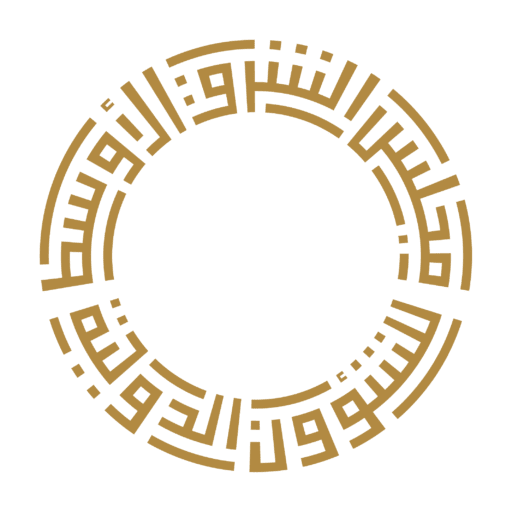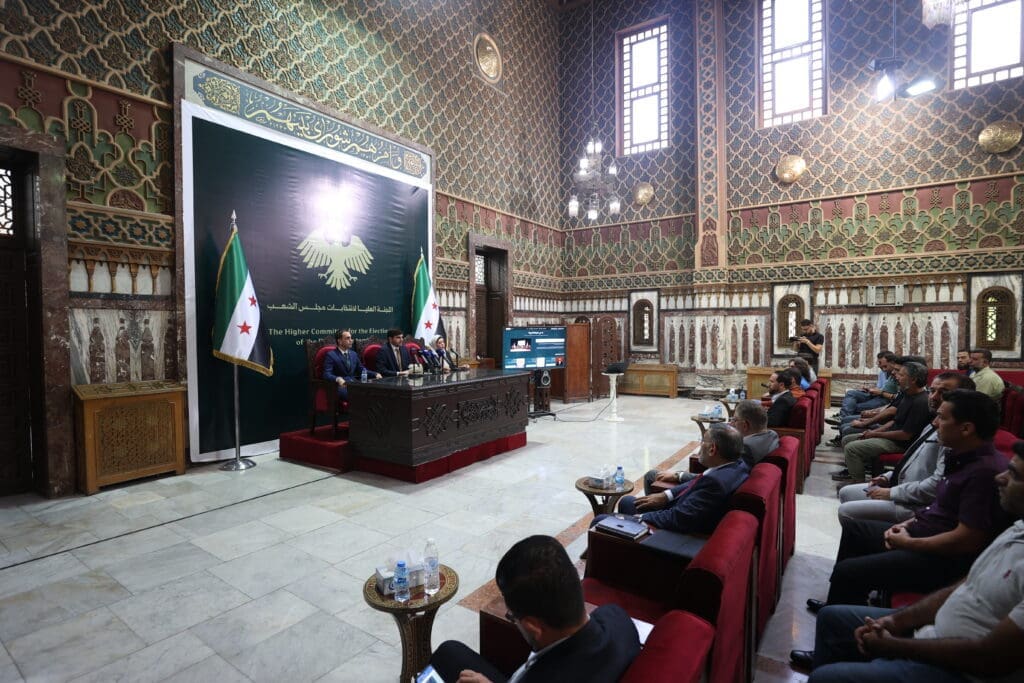Since the fall of Bashar al-Assad last December, Syria’s transitional authorities have revealed a dilemma at the center of the country’s new political order. What looks on the surface like electoral tinkering instead points to something deeper: a crisis of legitimacy, state capacity, and sovereignty, which will define Syria’s transition and reverberate across the region.
Just weeks after Assad’s ouster, the new government staged the “Victory Conference,” which installed Ahmed al-Sharaa as president. That was quickly followed by a “National Dialogue” that culminated in the announcement of a new constitution. Now, less than a year into this new era, the government has moved to set up Syria’s first post-Assad parliament. The presidency has introduced a temporary electoral law, presenting it as a step toward democratic representation. Yet the system excludes three key provinces over which Damascus has limited control, Sweida, Raqqa, and Al-Hasakah.
Compounding this void of representation, in August Syria’s transitional government issued Decree 143, introducing a “temporary electoral system” for the People’s Assembly. The decree establishes a 210-seat parliament, in which two thirds of members are to be chosen through newly created provincial electoral bodies, with the remaining third appointed directly by the presidency. The move ostensibly aims to broaden representation and encourage pluralism.
However, the mechanics tell a different story. The electoral bodies themselves are not publicly elected, but formed by subcommittees whose membership was already fixed by an earlier presidential decree. This replaces direct voting with a layered, indirect process: subcommittees within each governorate select delegates, who then choose parliamentarians.
The criteria for candidates are also restrictive. In addition to banning figures connected to the deposed Assad regime, the decree bars anyone linked to “secessionist” or “outlawed groups,” a judgment left entirely to the state’s discretion. Given the movements for autonomy or federalism in the Kurdish-dominated northeast and the Druze heartlands of the southwest, this raises doubts over how representative such a system can be.
For all the language of transparency and standards, the system centralizes power rather than dispersing it. The presidency retains the right to appoint a bloc large enough to sway majorities, block coalitions and ensure that loyalists occupy key committee posts. Meanwhile, millions of Syrians living abroad, including refugees and exiles, are offered no role in the process.
Unsurprisingly, human rights organizations and political analysts have dismissed the decree as largely cosmetic. Many warn it risks producing a parliament no more independent than its Baathist predecessor—remaining a “rubber stamp” legislature, but with a reshuffled cast of notables and technocrats under even tighter executive control.
The government has also postponed parliamentary elections in Sweida—partially controlled by Druze factions—and the Kurdish-led northeastern provinces of Raqqa and Al-Hasakah, citing a lack of effective state control. Weeks later, and without a new decree overriding the previous postponement, it started appointing electoral subcommittees in small government-controlled pockets of these provinces, such as Ras al-Ain in Al-Hasakah and Tal Abyad in Raqqa. These committees, made up mostly of local notables chosen by Damascus, are responsible for overseeing limited voting procedures.
This approach aims to give the appearance of inclusivity by allowing some residents to vote, even though most of these provinces are outside government control. However, in Sweida, the security situation and restrictions imposed by local armed groups have made even this limited electoral exercise impossible, leaving the province’s parliamentary seats vacant.
These parallel processes reveal the disjointed nature of state authority and the uneven distribution of power in Syria, undermining claims of national representation. The government’s approach aims to maintain a facade of electoral legitimacy in disputed areas, but in fact it highlights the shortcomings of inclusive democracy when entire cities and populations are denied the right to vote.
National Representation Without National Unity
The Syrian transition faces a fundamental contradiction: It seeks to project national representation and sovereignty in a country where borders and territorial control are contested and the population remains deeply fragmented.
On the one hand, the new administration is eager to reassure the international community. By staging parliamentary elections, even if only partial ones, it is seeking to give the impression of order and stability. Such gestures are designed to attract foreign re-engagement and, ultimately, the investment required for reconstruction.
Yet beneath this façade, exclusion and executive dominance define the process. The system leaves almost no room for genuine pluralism or grassroots political experimentation. Even the electoral bodies themselves are staffed by handpicked figures, ensuring that new institutions answer to the presidency rather than to citizens. In effect, the emerging political order may look different on the surface, but it rests on a foundation as brittle as the one it replaced.
Moreover, the consequences of Syria’s fractured transition will not be confined to its borders. The exclusion of entire regions and populations provides foreign powers with ready-made justifications for continued intervention. Israel frames its airstrikes and cross-border operations in southern Syria as necessary responses to perceived threats posed by the new authorities to Druze communities in Sweida and Daraa. In the Northeast, the U.S. continues to back Kurdish-led autonomous structures and keeps troops on the ground to secure Syria’s oilfields, over 90 percent of which remain under the control of the Syrian Democratic Forces. This is despite Washington’s public support for the transitional government, a reflection of the contradictions produced by the absence of a unified and legitimate state. So, too, are there internal policy divisions within the U.S. administration over how to engage with Syria’s new government, with officials split between supporting rapid normalization or for a more cautious approach due to ongoing security and governance concerns.
Such fragmentation complicates the plans of regional powers eager to re-engage in Syria. Türkiye, Qatar, Saudi Arabia and the UAE have all signaled their interest in postwar investment and economic partnerships. But as long as large areas and populations remain outside the national consensus, their ability to operate in a stable and predictable environment will remain limited.
Under Assad, the Syrian People’s Assembly was little more than political theater, a chamber built to rubber-stamp decisions and stage the appearance of unity, not to practice democracy. The reforms currently underway risk reviving that same façade, only with more sophisticated tools of control. Instead of creating space for diverse voices, the new system seems designed to contain and neutralize them. This is a sobering prospect for what was supposed to be the first parliament of a “Free Syria.”
By excluding representation from some of the country’s most complex and diverse provinces, the interim authorities are not solving the problem of legitimacy, they are legislating it into permanence. By tightening executive control over the assembly, they are stripping away one of the few potential outlets for national pressure and dissent, leaving frustration with nowhere to go but the streets.
Towards Inclusivity and Realism
The Syrian transitional government’s recent moves carry important lessons for policymakers and analysts at home and abroad. They underscore the immense difficulty of building new institutions in the shadow of authoritarian rule, in the midst of conflict and across a fractured national identity. At the same time, they reveal the practical struggles faced by a transitional government as it attempts to establish legitimacy and stability in a divided landscape.
The new authorities face a dual challenge: consolidating state power while operating in an environment where broad participation and direct elections are both politically and logistically hard to deliver. The reliance on indirect electoral mechanisms and selective inclusion reflects an attempt to manage a fragile state apparatus that must contend with insecurity, weak infrastructure and the competing claims of local actors. Recognizing these constraints is essential for crafting realistic pathways forward.
For Syria’s neighbors and international partners, these dynamics present both warnings and openings. Stabilization strategies should aim to support genuine political reform and inclusion, while remaining sensitive to the limits faced by a government still finding its footing. Effective engagement will depend on strengthening institutions that can gradually widen participation and representation, while ensuring that Syria’s diverse communities, ethnic groups and regions all have a stake in shaping the country’s future.
Ultimately, the real test of Syria’s postwar transition will not be the mere staging of elections or the formal creation of governing institutions. What will matter is whether these bodies can truly reflect the country’s diversity, address deep-rooted grievances and open space for peaceful political competition. Without that inclusivity, reforms that drive centralization risk hardening divisions rather than fostering reconciliation and building a cohesive national future.


